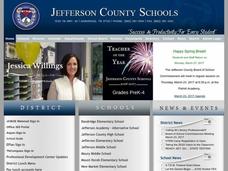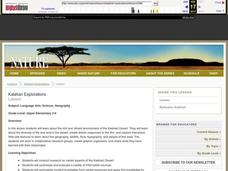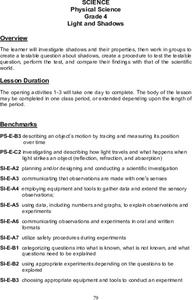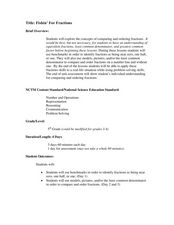Curated OER
What Do We Do With A Dirty Bomb?
Students examine composition of dirty bomb and its possible effects on a city, and investigate simulations of such an event; students use computational and problem solving skills to assess damage and prepare report proposing solution to...
Curated OER
Parade of People
Students explore making patterns. In this patterns lesson, students make patterns from the groups they are put in. Students can use items from around the room to make their patterns
Curated OER
Animals in Sports and Entertainment
Students explore how people's views on animal treatments differ. In this animal treatment and attitudes lesson, students review cases on animal treatment and evaluate whether or not the case was animal cruelty. Students understand...
Curated OER
Poet Naomi Shihab Nye
Learners read and analyze poetry by Naomi Shihab Nye. They define stereotypes, view and discuss a video interview with Nye, present an oral reading of a poem, and write a persuasive letter to an author.
Curated OER
Designing a Space Station
Students view pictures of the space station and discuss their feelings about living in a space station. They discuss the materials needed to build a space station and its various needs for operation. They read the NASA contest rules...
Curated OER
The Legacy of Rome
Students choose an element of Roman society they feel has had the most impact on modern society. Students then trace how that particular element has evolved over time and how it has influenced the development of its present equivalent...
Curated OER
Genre Study - Grade Three
Third graders learn to identify different types of literature genres. In this genre lesson plan, 3rd graders complete pre and post- assessment, conduct a genre research activity, and complete the associated worksheets.
Curated OER
Life is Full of Problems
Pupils use the problem solving strategy of guess and check to investigate math word problems. They determine which problem solving strategy or strategies would work best in problem situations.
Curated OER
Literature: Isabel Allende
Students watch and respond to a Bill Moyers Now video on the Chilean author, Isabel Allende. They brainstorm a list of recent events that might inspire writers and choose one to write about in poetic, diary, or short story form.
Curated OER
Systems 1: Simple Machines
Students explore the parts of a system and develop schema of the interactions between those parts. They examine a variety of simple hardware devicesand observe the interactions between the elements of the devices, through both hands-on...
Curated OER
Skeletal System
Seventh graders identify and label twenty-five bones of the skeletal system. In small groups they glue various types of dried pasta to a large human body outline. They attach the pasta to the outline and label the pasta bones.
Ohio Department of Education
Actions with Fractions: Adding and Subtracting Fractions with Common Denominators
Fourth graders develop a conceptual understanding of fractions and begin to add and subtract fractions with like denominators. Included is a worksheet to assess readiness and a teacher's checklist showing class understanding at a...
Curated OER
Recycling
Students relate recycling to waste reduction. In this science lesson, students talk about the environment and how recycling certain natural resources actually saves on energy. They also discuss what type of recycling causes...
Curated OER
Kalahari Explorations
Students explore world geography by completing graphic organizers and researching the Internet. In this Kalahari desert lesson, students identify the geographic location, weather and creation of the Kalahari desert. Students define a...
Curated OER
Kid-Friendly CDVs
Students discover core democratic values. In this service learning lesson, students create posters in order to promote core democratic values.
Curated OER
Fire Safety in the Home
Students discover the importance of fire safety. In this fire prevention activity, students identify problems in a house that could lead to a fire and draw their own homes that include the appropriate fire prevention tools. The students...
Curated OER
African Safari
Seventh graders examine different countries in Africa to research. They choose one to concentrate their research on using the five themes of geography. They design a multimedia presentation that will make up the African safari.
Curated OER
Light And Shadows
Fourth graders explore the properties of shadows. In pairs they trace each other's shadows in chalk and re-draw their shadow outlines every three hours, design their own shadow investigation, and complete various worksheets related to...
Curated OER
One-to-one Correspondence
Students count and keep track of objects using one-to-one correspondence. By moving, touching and pointing to objects they organize counting to determine the number in a set accurately. This helps students to practice the skill of...
Curated OER
Healthy Living:
Students are able to recognize a wide variety of fruit and have a greater understanding as to the importance of fruit in their diet and that some fruits skin are edible and others are not.
Curated OER
Keying Rocks
Fifth graders observe several examples of types of rock and write about their similarities and differences in their science journals. They discuss their observations and discover that rocks are grouped according to the scientific...
Curated OER
Which Amusement Park Would You Choose?
Students analyze data related to amusement parks and create a spreadsheet to display the data. They read the data and predict which amusement park they think is safer, create a spreadsheet and graph, and write a proposal based on their...
Curated OER
Sampling Rocks
Students investigate rocks. In this earth science lesson, students collect rocks from the schoolyard and describe each of the rocks. Students measure and weigh each rock and record the results. Students create a rock guide for the...
Curated OER
Fishin' For Fractions
Fifth graders compare fractions. In this fraction lesson, 5th graders identify whether a fraction is closest to zero, half, or one and use common denominators. They put fractions in order and complete real-life fraction questions.























